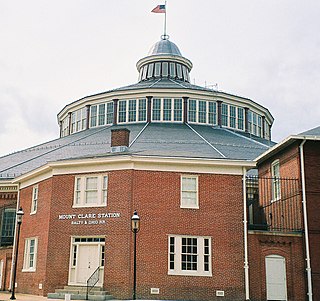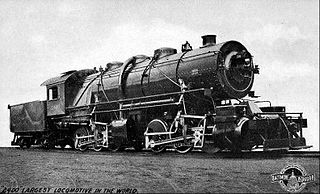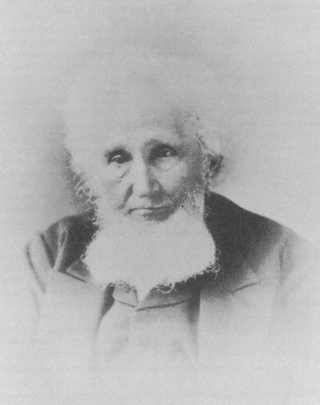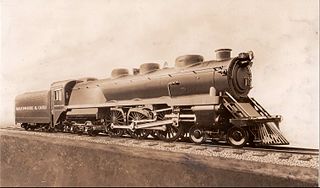
The Baltimore and Ohio Railroad was the first common carrier railroad and the oldest railroad in the United States with its first section opening in 1830. Merchants from Baltimore, which had benefited to some extent from the construction of the National Road early in the century, wanted to do business with settlers crossing the Appalachian Mountains. The railroad faced competition from several existing and proposed enterprises, including the Albany-Schenectady Turnpike, built in 1797, the Erie Canal, which opened in 1825, and the Chesapeake and Ohio Canal.

A geared steam locomotive is a type of steam locomotive which uses gearing, usually reduction gearing, in the drivetrain, as opposed to the common directly driven design.
The Pennsylvania Railroad, legal name The Pennsylvania Railroad Company, also known as the "Pennsy", was an American Class I railroad that was established in 1846 and headquartered in Philadelphia. It was named for the commonwealth in which it was established. At its peak in 1882, the Pennsylvania Railroad was the largest railroad, the largest transportation enterprise, and the largest corporation in the world.

A 2-8-8-4 steam locomotive, under the Whyte notation, has two leading wheels, two sets of eight driving wheels, and a four-wheel trailing truck. The type was generally named the Yellowstone, a name given it by the first owner, the Northern Pacific Railway, whose lines ran near Yellowstone National Park. Seventy-two Yellowstone-type locomotives were built for four U.S. railroads.

The B&O Railroad Museum is a museum and historic railway station exhibiting historic railroad equipment in Baltimore, Maryland. The Baltimore and Ohio Railroad (B&O) company originally opened the museum on July 4, 1953, with the name of the Baltimore & Ohio Transportation Museum. It has been called one of the most significant collections of railroad treasures in the world and has the largest collection of 19th-century locomotives in the U.S. The museum is located in the Baltimore and Ohio Railroad's old Mount Clare Station and adjacent roundhouse, and retains 40 acres of the B&O's sprawling Mount Clare Shops site, which is where, in 1829, the B&O began America's first railroad and is the oldest railroad manufacturing complex in the United States.

A camelback locomotive is a type of steam locomotive with the driving cab placed in the middle, astride the boiler. Camelbacks were fitted with wide fireboxes which would have severely restricted driver visibility from the normal cab location at the rear.

Under the Whyte notation for the classification of steam locomotives, 4-4-4 represents the wheel arrangement of four leading wheels on two axles, four powered and coupled driving wheels on two axles, and four trailing wheels on two axles. In the United States, this arrangement was named the Reading type, since the Philadelphia and Reading Railroad was the first to use it. In Canada, this type is known as the Jubilee.

The 2-6-6-6 is an articulated locomotive type with two leading wheels, two sets of six driving wheels and six trailing wheels. Only two classes of the 2-6-6-6 type were built. One was the "Allegheny" class, built by the Lima Locomotive Works. The name comes from the locomotive's first service with the Chesapeake and Ohio Railway beginning in 1941, where it was used to haul loaded coal trains over the Allegheny Mountains. The other was the "Blue Ridge" class for the Virginian Railway. These were some of the most powerful reciprocating steam locomotives ever built, at 7,500 hp, and one of the heaviest at 386 tons for the locomotive itself plus 215 tons for the loaded tender.

Under the Whyte notation for the classification of steam locomotives, a 0-6-6-0 wheel arrangement refers to a locomotive with two engine units mounted under a rigid locomotive frame, with the front engine unit pivoting and each engine unit with six coupled driving wheels without any leading or trailing wheels. The wheel arrangement was mostly used to describe Mallet locomotive types.

Tom Thumb was the first American-built steam locomotive to operate on a common-carrier railroad. It was designed and constructed by Peter Cooper in 1829 to convince owners of the newly formed Baltimore and Ohio Railroad (B&O) to use steam engines; it was not intended to enter revenue service. It is especially remembered as a participant in a legendary race with a horse-drawn car, which the horse won after Tom Thumb suffered a mechanical failure. However, the demonstration was successful, and the railroad committed to the use of steam locomotion and held trials in the following year for a working engine.

A jackshaft is an intermediate shaft used to transfer power from a powered shaft such as the output shaft of an engine or motor to driven shafts such as the drive axles of a locomotive. As applied to railroad locomotives in the 19th and 20th centuries, jackshafts were typically in line with the drive axles of locomotives and connected to them by side rods. In general, each drive axle on a locomotive is free to move about one inch (2.5 cm) vertically relative to the frame, with the locomotive weight carried on springs. This means that if the engine, motor or transmission is rigidly attached to the locomotive frame, it cannot be rigidly connected to the axle. This problem can be solved by mounting the jackshaft on unsprung bearings and using side-rods or chain drives.

Ross Winans (1796–1877) was an American inventor, mechanic, and builder of locomotives and railroad machinery. He is also noted for design of pioneering cigar-hulled ships. Winans, one of the United States' first multi-millionaires, was involved in national and state politics, a southern-sympathizer and was a vehement "states' rights" advocate. Winans was briefly arrested after the Baltimore riot of 1861. His outspoken anti-federal stance as a member of the Maryland House of Delegates, the lower chamber of the General Assembly, led to his temporary arrest on May 14, 1861. At the time of his arrest, Winans was returning on a Baltimore and Ohio Railroad train from an early session of the legislature that was being held in the western Maryland town of Frederick to avoid the Union Army-occupied state capital of Annapolis in April–May 1861 to consider the possibilities of state secession during the early decisive period of the American Civil War. Winans was related to James McNeill Whistler through marriage.
Phineas Davis was a well-known clockmaker and inventor who designed and built the first practical American coal-burning railroad locomotive.

The Baltimore & Ohio Railroad's sole class V-2 4-6-4 steam locomotive, No. 2 Lord Baltimore, was constructed by the railroad's own Mount Clare Shops in 1935. It was built under the direction of the road's master mechanic George Emerson, and said to have been inspired by the Great Western Railway locomotive 6000 King George V which had appeared at B&O's 1927 Fair of the Iron Horse. The locomotive was constructed with an experimental water tube firebox, and operated at 350 psi when more typical operating pressure was 250 psi. The 84-inch drive wheels were the biggest ever on B&O steam. It was constructed to haul a new lightweight train, the Royal Blue, between New York City and Washington, DC. Later that year it was sent to the B&O-owned Chicago & Alton Railroad. It returned to the B&O in 1942 and, after work in B&O's shops, was renumbered to #5340 and assigned to service between Washington, DC and Cumberland, Maryland. Shortly afterward, it was withdrawn from service and stored at the railroad's shops in Baltimore, Maryland, and was scrapped in 1949.
On the Baltimore and Ohio Railroad, locomotives were always considered of great importance, and the railroad was involved in many experiments and innovations.

The Mount Clare Shops is the oldest railroad manufacturing complex in the United States, located in Baltimore, Maryland. It was founded by the Baltimore and Ohio Railroad (B&O) in 1829. Mt. Clare was the site of many inventions and innovations in railroad technology. It is now the site of the B&O Railroad Museum. The museum and Mt. Clare station were designated a National Historic Landmark in 1961.

"Mount Winans" is a mixed-use residential, commercial and industrial neighborhood in the southwestern area of the City of Baltimore in Maryland. Its north, south and east boundaries are marked by the various lines of track of the CSX Railroad. In addition, Hollins Ferry Road running to the south towards suburban Baltimore County in the southwest and further connecting with adjacent Anne Arundel County to the southeast, draws its western boundary.

The Baltimore and Ohio’s P-7 class was a class of 20 Pacific type locomotives built in 1927. Named for the first 20 Presidents of the United States, they were the prime motive power for the B&O’s top passenger trains for 31 years. One example, Baltimore and Ohio 5300, the "President Washington", has been preserved.

Baltimore and Ohio 4500 is a 2-8-2 "USRA Light Mikado" steam locomotive built by the Baldwin Locomotive Works in Philadelphia, Pennsylvania in July 1918 for the Baltimore and Ohio Railroad (B&O) as a member of the Q-3 class.
Baltimore and Ohio No. 5300, also known as President Washington, is the sole survivor of the P-7 class 4-6-2 "Pacific" type steam locomotives. It was built by Baldwin in 1927, and it was used on mainline passenger trains across the Baltimore and Ohio system, particularly the Royal Blue train, until it was retired in 1957. After being stored for a few years, it was donated to the Baltimore and Ohio Railroad Museum in Baltimore, Maryland, where it has spent several years on static display. The locomotive is undergoing a cosmetic restoration, as of 2023.
















